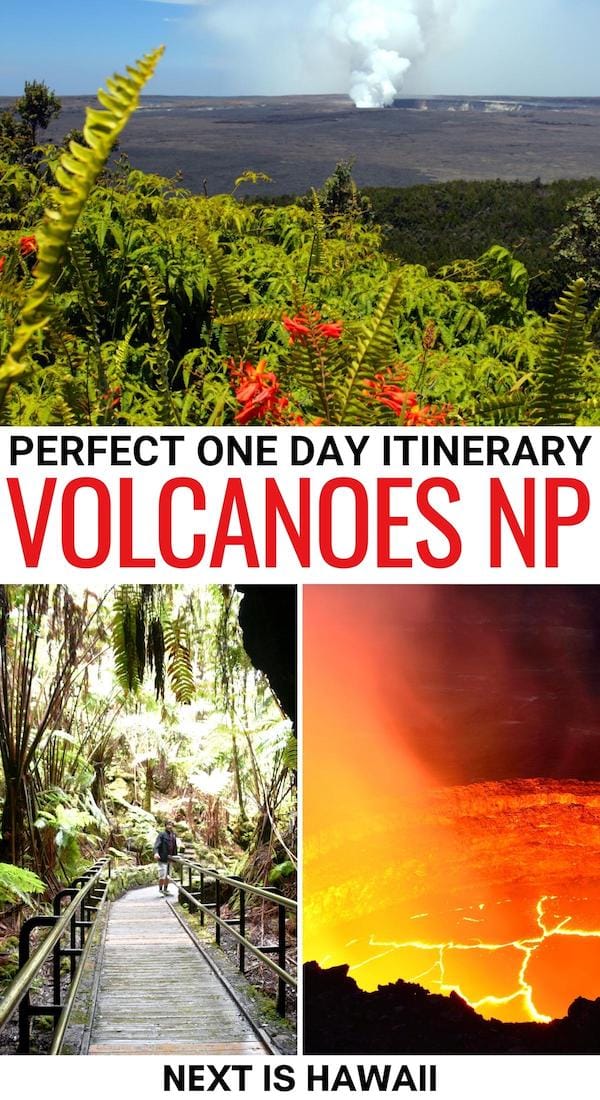Last Updated on June 16, 2025 by Aram Vardanyan
Hawaii Volcanoes National Park is one of the most spectacular sites on the Big Island (and in the whole state!).
This is a one day in Volcanoes National Park itinerary for those looking to embark on a day trip there!
If you’re traveling to Volcanoes National Park last minute, you want to ensure you have tours booked ahead of time! Below are our top picks!
Best Tours from Hilo to Hawaii Volcanoes NP:
- Evening Volcano Explorer from Hilo (6 hours long)
- Active Volcano, Lava Tube, Waterfall and More (also stops by Rainbow Falls)
- Hawaii Volcanoes National Park and Hilo Highlights (5.5 hours)
- Elite Volcano Hike From Hilo (9 hours)
Best Tours from Kona to Hawaii Volcanoes NP:
- Volcanoes National Park and Kona Coffee Farm (12 hours)
- Big Island Twilight Volcano and Stargazing Tour (10 am until 11 pm)
Additional options for renting a car:
- Private tour of Volcanoes National Park (starts inside of the park!)
- Shaka Guides audio and GPS guide (less than $15!)
Traveling to the Big Island independently? Be sure to book your rental car ahead of time to ensure availability!
🏥 Looking for the best insurance for traveling to Hawaii? Click here to check Hawaii’s insurance rates with SafetyWing!
Home to two of the most active volcanoes in the world, Kilauea and Mauna Loa, the park houses some of the most beautiful and cherished landscapes and natural wonders in the world.
In addition, the park is a sacred place for the Hawaiian people, so visitors will be able to learn more about the culture and importance of the sights within the Hawaiian National Park.
If you have a limited amount of time during your trip to Hawaii, one day might be all you can spare for a trip to Volcanoes National Park.
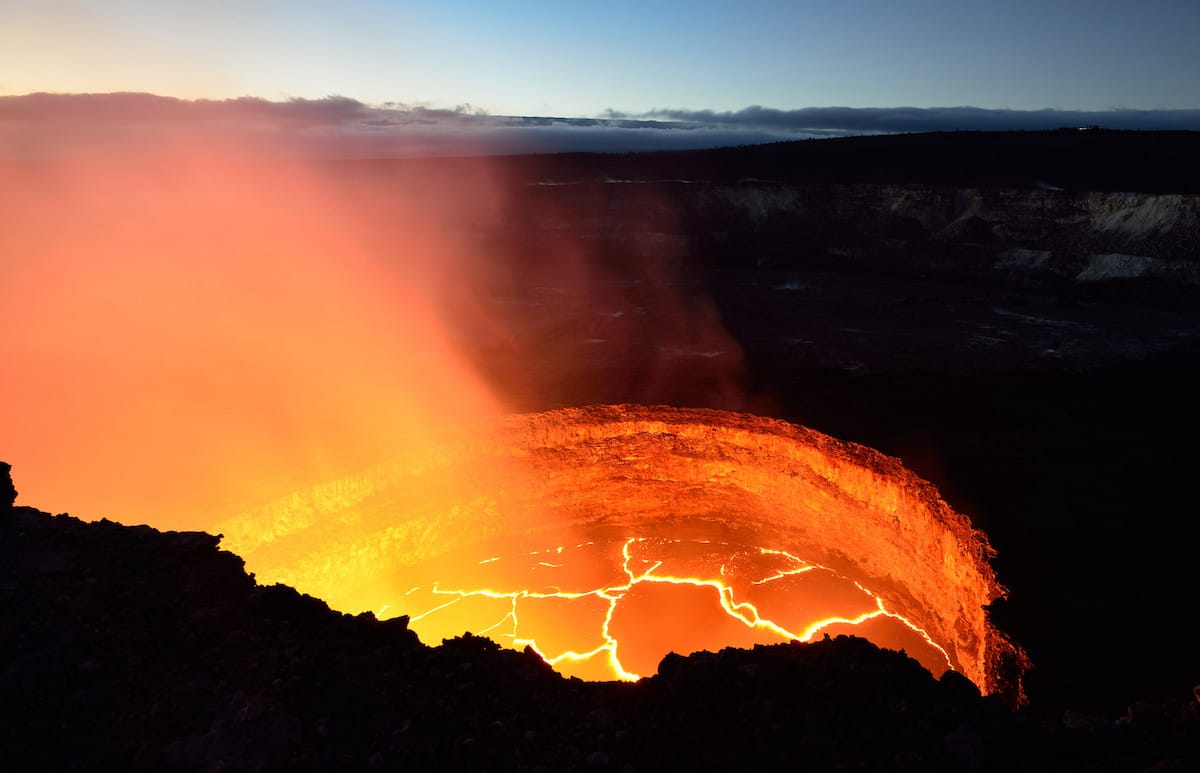
And while you can easily spend more than a day in Volcanoes National Park, it is certainly enough time to explore the park deeply if you’re coming from Hilo or nearby.
This guide will break down the main attractions in Hawaii Volcanoes National Park and give options for a half-day and a one-day itinerary for Hawaii Volcanoes National Park. We also include nearby sights if you have more than a day there.

Also included are some tips to help you plan your day trip to Hawaii Volcanoes National Park as well as some of the best tours to take you there without a car!
Let us know if you have any questions in the comments! Thanks!
Contents
- Planning Your Trip to Hawaii Volcanoes National Park
- Hawaii Volcanoes National Park Attractions + Highlights
- Half-Day at Hawaii Volcanoes National Park Itinerary
- One Day in Hawaii Volcanoes National Park Itinerary
- More Than 1 Day in Volcanoes National Park?
- Other Hawaii Itineraries
- More Big Island Travel Guides
- Pin this Day Trip to Hawaii Volcanoes National Park Guide
Planning Your Trip to Hawaii Volcanoes National Park
Best Time to Visit Hawaii Volcanoes National Park
Although Hawaii is rather warm all year round, it is important to note that Volcanoes National Park is a bit colder and wetter than the rest of the state.
Considering its altitude of 4,000 feet above sea level and luscious rainforests nearby, the 200 inches of rain the park gets annually can really make it cooler than you’d think.
In our opinion, the best time to visit Hawaii Volcanoes National Park is in the spring because the park is warm, but there aren’t many visitors.
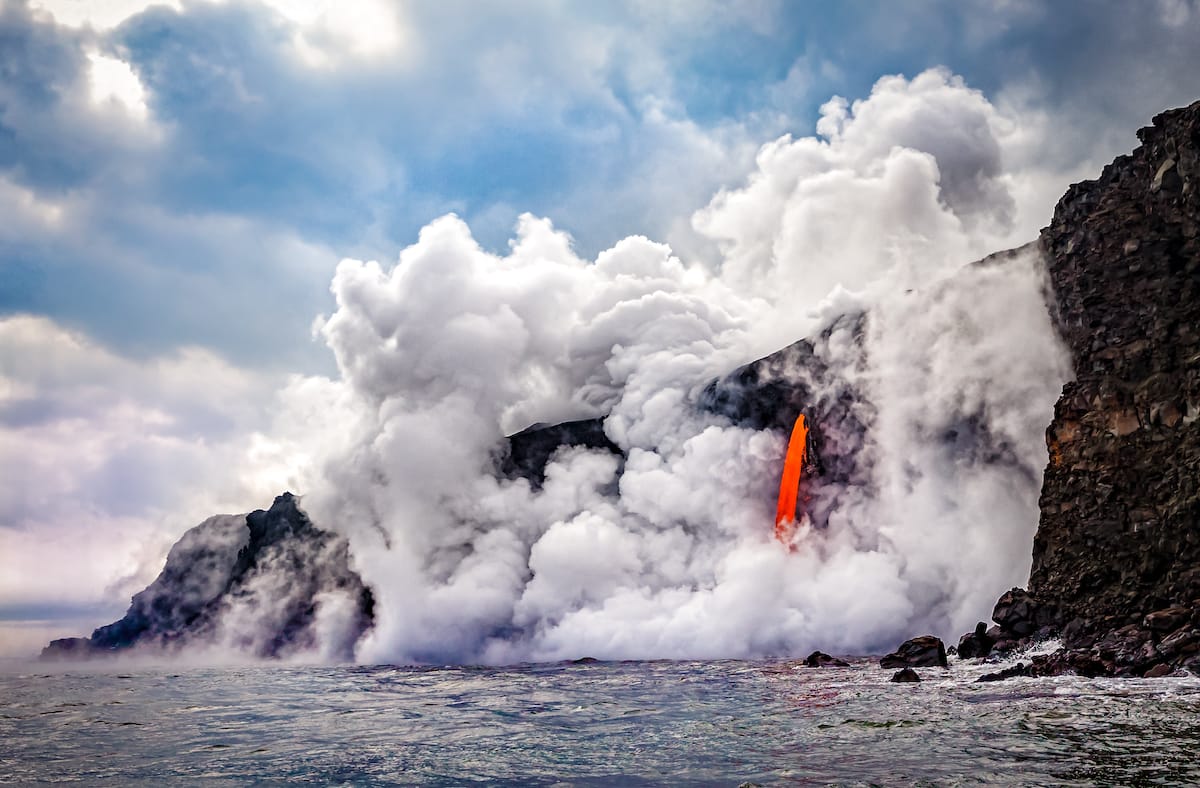
Summer is also a great time to visit, but you’re going to face far larger crowds in June and July.
In addition, November to March is the rainy season, so the area can be subject to torrential rain and strong winds. In short – visit in the spring!
Volcanoes National Park Kilauea Visitor Center
The first stop that we recommend before you embark and truly explore the park is to visit the Hawaii Volcanoes National Park Kilauea Visitor Center where it is possible to get information about what to do in the park, where to hike, and details about other activities.
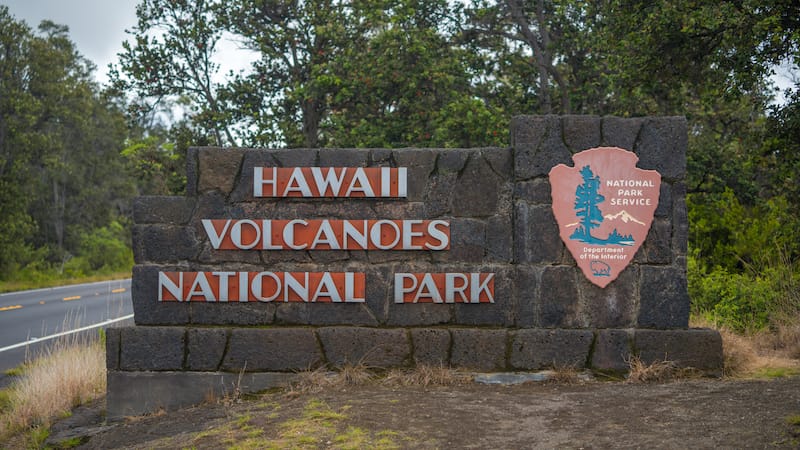
The visitor center is open all week from 9:00 AM to 5:00 PM and is closed on public holidays. Click here for additional information.
While the visitor center closes, the park itself is open 24 hours a day.
Entrance Fee
In order to visit Volcanoes National Park, the fee is $15 per person if traveling by foot or bicycle, $25 per motorcycle, and $30 per vehicle.
Is Kilauea Erupting?
The world’s most active volcano is often doing its thing, so the best way to keep up with its activity is to head over to the daily report on the National Park’s website.
How to Get to Volcanoes National Park
If you are coming from Hilo, drive 30 miles southwest on Highway 11, which should be a 45-minute drive. You can also get there within 2 to 3 hours on Highway 11 if you’re coming from Kailua-Kona or in 2 hours on Highway 200 from Waikoloa.
You can also try to use public transportation, such as Hele-On Bus, but it has limited routes. Many people prefer to use rental cars to make the journey… but you can also take a tour (we mention this below).
However, keep in mind that there is no public transportation in the park, and ride-sharing companies most often don’t take visitors.
The main roads in the park are Crater Rim Drive, Chain of Craters Road, Hilina Pali Road, and Mauna Loa Road.
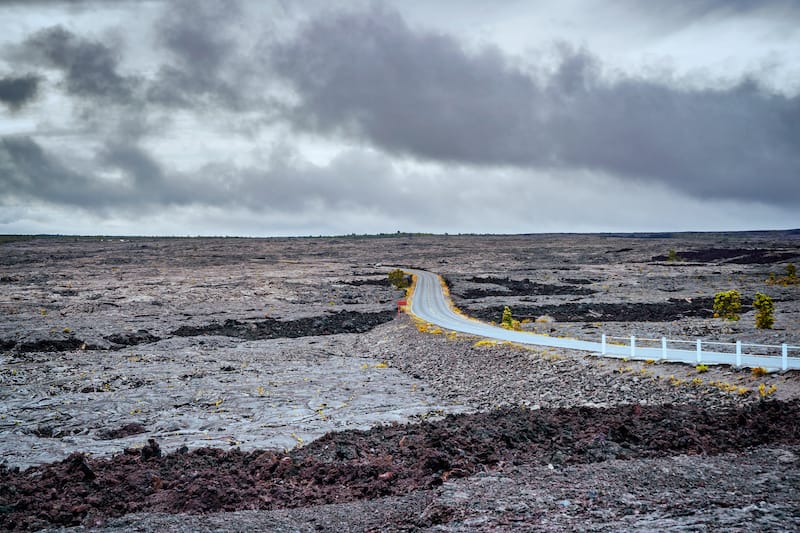
Best Day Tours to Hawaii Volcanoes National Park
This guide is written targeting those with a car but if you are taking a day tour to Hawaii Volcanoes National Park… it truly is a great option!
I have only visited one time and I actually bummed a ride with my friend’s friends but did my own thing for part of the day.
Here are some top-rated Hawaii Volcanoes National Park tours to consider if renting a car is not for you. Please note the location where the tours depart from to ensure it works for where your accommodation is (we have broken it into sections).
Tours to Volcanoes National Park from Hilo
You will find several tours taking you to Volcanoes National Park from Hilo. It is only 45 minutes away (about 30 miles), and it really is the best location to base yourself for the excursion.
However, do note that Hilo is rainy so perhaps don’t book a stay there for your entire Big Island trip. Below are the top-rated tours from Hilo to Hawaii Volcanoes National Park.
- Evening Volcano Explorer from Hilo (leaves at 1230, 6 hours long, also stops by Volcano Winery and Kalapana)
- Hilo Shore Excursion: Active Volcano, Lava Tube, Waterfall and Gardens (5.5 hours long, also stops by Rainbow Falls)
- Hawaii Volcanoes National Park and Hilo Highlights (small group tour, 5.5 hours)
- Elite Volcano Hike From Hilo (9 hours, will trek the 2018 Kilauea lava flow and more, leaves at 0930)
Tours to Volcanoes National Park from Kona
The best thing about staying in Kona is that the area is known for sunshine and pretty perfect weather conditions. Hilo is quite the opposite. However, you will be a lot further away from Volcanoes National Park!
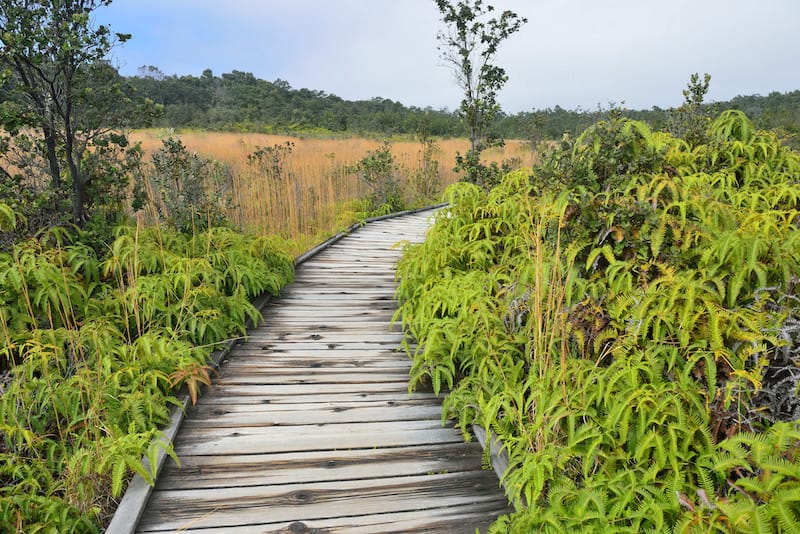
If you’re visiting Kona and want to book a day trip to Volcanoes National Park from Kona, the tours below will help you do so! Please note that most tours include other sights, so plot an entire day for the trip!
- Hawaii Volcanoes National Park and Kona Coffee Farm (12 hours, will also stop by Punalu’u Beach)
- Big Island Twilight Volcano and Stargazing Tour (small group, 10 am until 11 pm)
Private Tour (Meet at Hawaii Volcanoes National Park)
If you have a rental car for your trip but still are keen to hire a guide for the day in Hawaii Volcanoes National Park – this private tour is the perfect option for you and your travel companions!
You will meet your tour guide at the Volcano House Hotel in Pahoa at the park and will have 5-6 hours of skilled expertise as you explore the grounds of this national park!
>> Click here to check tour rates and availability
Audio Driving Tour of Volcanoes National Park
Another great option for those with a rental car is to book an audio tour with Shaka Guides. These are, hands down, the best and most recommended audio guides for your trip!
They have GPS-guided audio tours for you and are super affordable (less than $15)!
>> Click here to book a Shaka Guides audio guide to Volcanoes NP
Hawaii Volcanoes National Park Attractions + Highlights
As noted above, the way we have organized this guide is that we have included the park’s main highlights directly below this text and then we have created suggested itineraries at the bottom of the guide depending on the length of time you have to spend at the park.
Please also note that we discuss the two roads below (Chain of Craters Road and Crater Rim Road) as though they were their own drive entirely… just giving some highlights along the way.
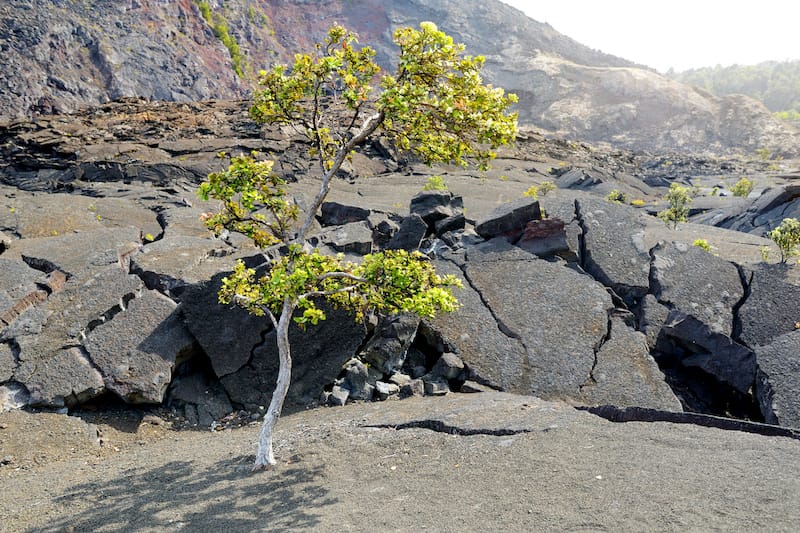
The actual itineraries of individual attractions and things to do in Hawaii Volcanoes National Park are toward the bottom of the guide.
We hope you find this useful and please reach out if you have any questions!
Chain of Craters Road
Chain of Craters Road is the most scenic drive of Hawaii Volcanoes National Park. It is filled with lava fields, flows, and pit craters. The road stretches for 19 miles from the summit of Kilauea Volcano to the sea.
If solely driving the road, your trip will start from several pit craters, including Lua Manu and Koʻokoʻolau. Then, take a trip down Hilina Pali Road, and see breathtaking views at the end of the road.
About four miles in, you’ll find several campgrounds like Kulanaokuaiki, the old Kipuka Nene Campground.
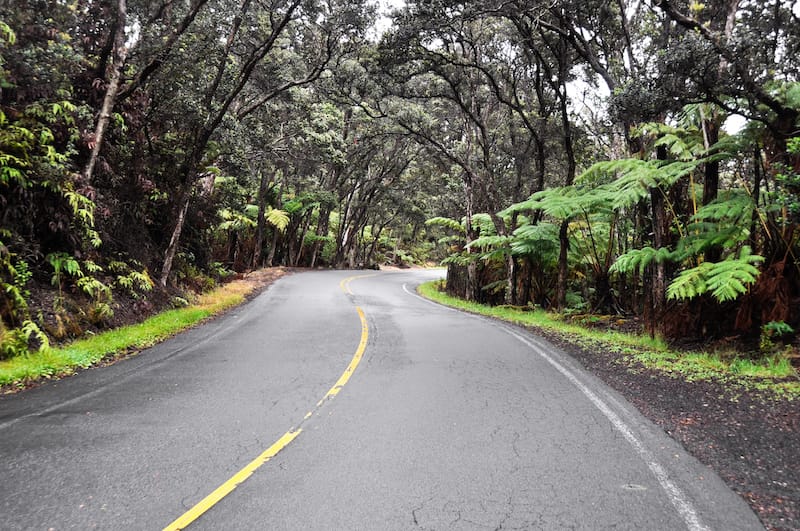
The next stop is at a 150-foot-wide and 165-foot-deep crater called Devil’s Throat. Further down the road, you’ll see the Hi’iaka and Pauahi Craters.
Other must-sees are the 7-mile-long Napau Crater Trailhead with fascinating landscapes, Mau Loa O Mauna Ulu, a black sea of pahoehoe lava, Halona Kahakai pullout with opportunities to view the coast, Pu’u Loa Petroglyph Field, and Holei Sea Arch.
Crater Rim Drive
Crater Rim Drive is an 11-mile road that travels across the Kilauea summit caldera from Uēkahuna to Keanakākoʻi Crater and boasts picturesque vistas and hiking opportunities. A good place to start your trip is at the Kilauea Visitor Center.
The rangers will provide you with all the necessary information and a map. Wander for several minutes in the museum to get acquainted with the life of the area.
Guided tours and public restrooms are also available. To the left, check out the Volcano Center Art Gallery, where you can enjoy local artwork. The Volcano House is a lodging place for visitors dating back to 1846.
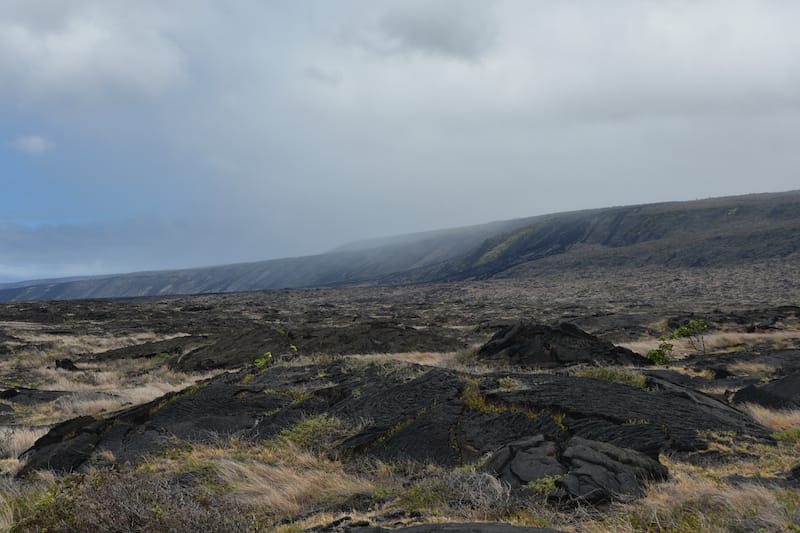
Some prominent guests of the house have included Mark Twain and President Franklin D. Roosevelt.
Furthermore, visit Sulfur Banks, an open area covered with sulfur, Steam Vents, the beating heart of the volcano, Jaggar Museum & Hawaiian Volcano Observatory, Southwest Rift Zone, Keanakako’ i Overlook, and Kilauea Iki Overlook.
Steam Vents
One mile past the Kilauea Visitor Center, you’ll find the Steam Vents area. Hawaiians call it Wahinekapu. Groundwater and rain seep into the warm rocks and evaporate, returning to the surface as steam.
You can explore this thermal wonder and feel the breath of Mount Kilauea. The landscape here changes from rain forests to grassy fields as only some shallow-rooted plants can survive in this region.
Enjoy a short walk on a trail starting from the Steam Vents parking lot and stretching to Steaming Bluff. The area bears unique cultural significance.
Hawaiians come here to get rid of bad toxins. This is also the place where they present offerings to Pele, the volcano deity.
Devastation Trail
Wheelchair and stroller accessible? Yes
The Devastation Trail is one of the main volcanic sites you can reach from Crater Rim Drive. This paved path stretches through the landscape buried under the cinder from lava fountains dating back to the 1959 Kilauea Iki eruption.
There’s a parking place at the beginning of the trail. The trail is easy to walk and spans merely a mile round trip.
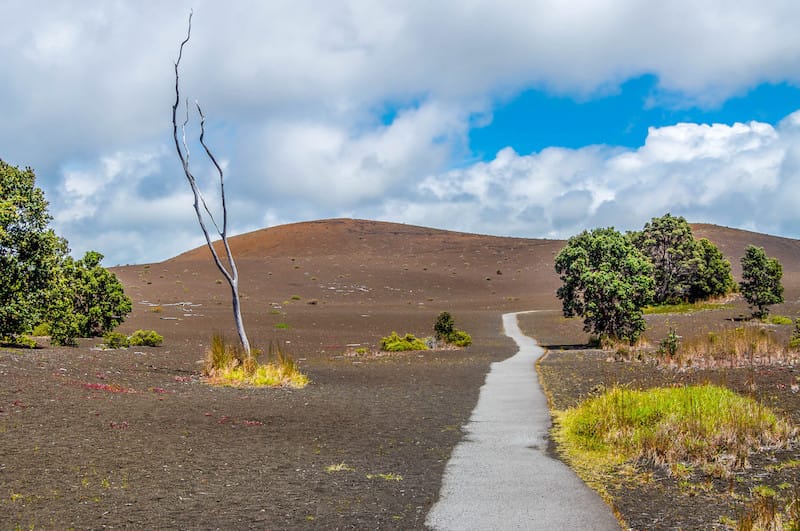
Along your way, stop at the Kilauea Iki Crater and walk to a former lava lake. After a short walk through a tree-lined path, you’ll reach the lands devastated by lava.
Take a closer look at the ground, and you’ll see volcanic debris in the form of strands, which are drops called Pele’s Tears and Hair.
If you’re lucky, you’ll see Hawaiian geese, known as nene, on your path.
Halema’uma’u Crater
Halemaʻumaʻu Crater is a pit crater located within the Kīlauea Caldera at the top of Kīlauea volcano. This is the most active vent of the volcano. The name means house of the amaʻu fern.
The crater is about 280 feet deep and 3,000 feet across. Its size has significantly changed over the last century because the magma flows under the surface and sometimes erupts, filling the crater’s floor.
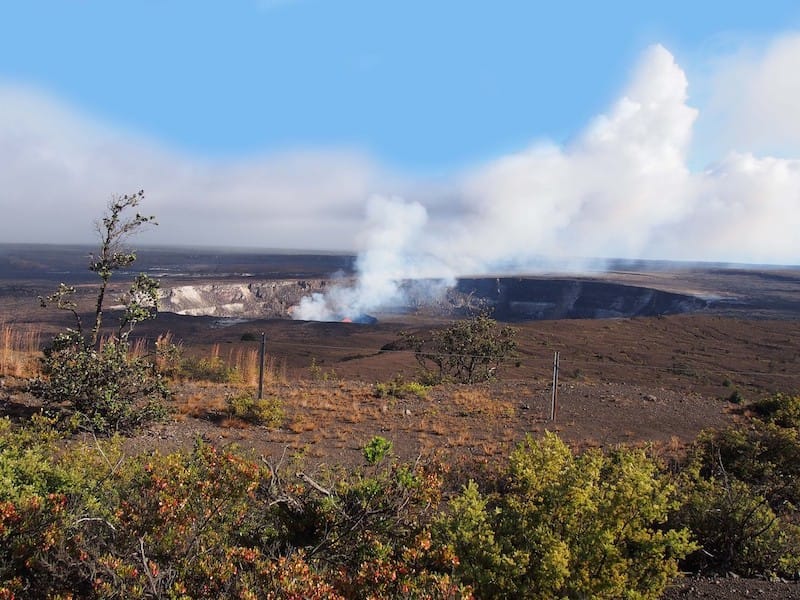
The Halemaumau Crater emits tons of sulfurous gas steaming up through the cracks in the black lava rock. A small water pond appeared in Halemaʻumaʻu in 2019 that was boiled away in 2021 and refilled with lava.
Halema‘uma‘u is regarded to be the home of the Hawaiian fire goddess Pele. Not far from Halema‘uma‘u, on the western rim of Kilauea, you can check out the Hawaiian Volcano Observatory.
To visit, you must hike the moderately-difficult trail. It is not wheelchair or stroller-friendly.
Holei Sea Arch
Hōlei Sea Arch is located at the end of Chain of Craters Road. Take a short walk along the road, and you’ll see a massive lava rock formation about 90 feet high stretching from the sea cliffs into the Pacific Ocean.
This basalt formation was born from marine erosion in which the waves of the ocean made a natural bridge.
Holei Arch is one of the youngest sites of Volcanoes National Park. It was created only in the last 100 years!

But the arch may also be the next to disappear because the recent earthquake activity that takes place on the volcano, as well as the waves, may finally cause the arch to collapse.
The Hōlei Sea Arch Trail is open for hiking, but it’s closed for horse riding and biking. Be sure to stay back from the cliff edge and follow all the instructions when you’re embarking on this Volcanoes National Park day hike.
Kīlauea Iki (Trail)
In 1959, the eruption of Kīlauea Iki Crater became the most spectacular lava sight of the 20th century. It lasted for 36 days and created unique opportunities for geologists to study the ongoing processes of the Kīlauea volcano.
The eruption began when a curtain of lava burst from a half-mile crack. Later, fountains of lava appeared from the vent and flooded the crater, creating a lava lake.
When the lava lake grew higher than the vent, the eruption stopped. Lava started pouring back into the vent faster and faster.

The large cinder cone on the left of the crater, Puʻupuaʻi, was formed. Today, one can see this bathtub ring on the walls of the crater and walk on its lava-formed floor.
Although Kīlauea Iki is peaceful(ish) now, you can still feel the pulsating magma through the volcano.
To reach the site, drive along Crater Rim Road for a few miles until you find the large parking place for the Kīlauea Iki Trail. It is not a wheelchair or stroller-friendly trail.
Pu‘uloa Petroglyphs
Pu‘uloa means “a long hill” and is a sacred place for Hawaiian people. Situated on the southern part of the Kīlauea volcano, Puʻuloa is a vast area containing numerous images carved into the hardened lava, called petroglyphs.
The site covers more than 23,000 unique petroglyphs. The Pu’uloa Petroglyphs were carved by the ancestors of the Pueblo people from about 1300 through the late 1680s.
Some of them even pre-date the Puebloan period, dating back to 2000 B.C.
Here, you’ll also find small holes in which the locals used to put their newborns’ umbilical cords to grant them a long life.

To avoid damaging the petroglyphs, the park administration constructed a boardwalk above the surface where visitors can walk along and view the site.
Drive along the Chain of Craters Road, proceed about 16 miles, and you’ll see a road sign marking the petroglyph field.
Nāhuku (Thurston Lava Tube)
Thurston Lava Tube, or Nāhuku, is a 500-year-old massive lava cave. The flows of molten lava caused the cave to form its shape. The active lava flows through the tunnels at about 2,000º F, and when it stops or gets diverted, it leaves empty caves behind.
There are several similar caves throughout the park, but Nahuku is the most accessible and definitely the most famous.
The Thurston Lava Tube was discovered in 1913. Lava drippings once covered its roof, which later disappeared because of souvenir collectors.

The entrance of the cave is equipped with electric lights and has a flat rock floor, but after a short stroll, you’ll reach the section that is completely dark with an uneven floor, so be sure to have strong flashlights.
You can have a short day hike into the tube from Crater Rim Drive passing through the Hawaiian rainforest while enjoying bird watching.
Volcano House Hotel
With its iconic location and dramatic views, the house always attracts visitors from all over the world. Mark Twain was known to stay here and wrote about it in the book Roughing It.
The oldest building regarded as the predecessor to Volcano House dates back to 1846. It was built by Benjamin Pitman, the husband of Princess Kinoʻole o Liliha Hoʻolulu and a famous businessman.
Today, the Volcano Art Center is also situated here. The restored Volcano House provides 33 guest rooms overlooking Kilauea caldera, a dining room, snack bar, lounge, and gift shop, as well as cultural events and exhibits.
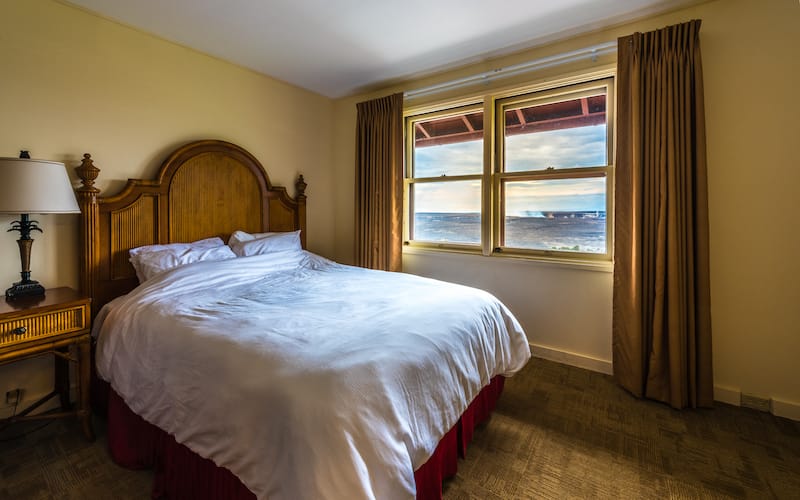
Guests can access a lending library, board and card games, free bicycle rentals, and guided tours around the park. It also boasts camper cabins and campsites in the nearby Nāmakanipaio Campground.
This is the only hotel inside Hawaii Volcanoes National Park.
If you’re taking a private tour of Volcanoes National Park, your meeting point may be here!
Half-Day at Hawaii Volcanoes National Park Itinerary
To be 100% honest with you, a half-day trip to Hawaii Volcanoes National Park will only work if you’re already in the vicinity of the park (or in Hilo).
When I went, I pretty much spent a half-day at Volcanoes National Park (6-8 hours in total) as I stopped by several places nearby beforehand. However, I did not do any super crazy hikes that day and only visited the main attractions within the park.
Here is a short itinerary of Hawaii Volcanoes National Park for those with only a short amount of time to visit the park!
- Kilauea Visitor Center (closes at 5pm so go on your way into the park)
- Steam Vents (these are worth a quick stop and if you want to see more, you can take the Sulphur Banks Trail which is mentioned in the second itinerary option)
- Kilauea Lookout / Halemaumau Crater (when I was last here, it offered a glimpse of lava but who knows now. Apparently, lava is back as of September 2021, however)
- Kilauea Iki Overlook (this offers a view of the entire crater!)
- Thurston Lava Tube (you only need 15-20 minutes here but it is an essential stop)
- Kilauea Iki Trail (this trail can be long or short – you can take the short one from the Thurston Lava Tubes parking lot if pressed for time). Be careful of rocks along the way and at the bottom!
- Devastation Trail (this trail only needs about 30 minutes but is a park highlight)
- Pu’u Loa Petroglyph Hike (I love this hike and it is only an hour-long max – about 20 minutes each way)
While many may recommend getting an early start in the park, I actually loved visiting in the afternoon as I got to see the sunset there and see the crater at night filled with lava.
I have no idea if the lava is there today as it disappeared in May and was back by September – either way… worth a stop!
One Day in Hawaii Volcanoes National Park Itinerary
If you have a full day at Volcanoes National Park, you will be able to take your time a bit more inside of the park and enjoy some of the hikes there without feeling pressed for time.
Here is our recommended itinerary for spending one day in Volcanoes National Park:
- Kilauea Visitor Center (closes at 5pm so go on your way into the park)
- Steam Vents (these are worth a quick stop and if you want to see more, you can take the Sulphur Banks Trail which is mentioned in the second itinerary option)
- Kilauea Lookout / Halemaumau Crater (when I was last here, it offered a glimpse of lava but who knows now. Apparently, lava is back as of September 2021, however)
- Sulphur Banks Hike (1.2-mile hike round trip along a paved path – easy and great for kids as there are many steam vents!)
- Kilauea Iki Overlook (this offers a view of the entire crater!)
- Thurston Lava Tube (you only need 15-20 minutes here but it is an essential stop)
- Kilauea Iki Trail (this trail can be long or short – you can take the short one from the Thurston Lava Tubes parking lot if pressed for time). Be careful of rocks along the way and at the bottom! I actually enjoyed the longer version of this hike and it doesn’t take too long.
- Devastation Trail (this trail only needs about 30 minutes but is a park highlight)
- Puhimau Crater (only need about 10 minutes here)
- Mauna Ulu Eruption Trail (easy, half-hour hike loop trail – this actually is a short part of a much longer hike!)
- Pu’u Loa Petroglyph Hike (I love this hike and it is only an hour-long max – about 20 minutes each way)
- Holei Sea Arch (you will see the ocean from here… there are also a ranger shed, picnic tables, and restrooms)
More Than 1 Day in Volcanoes National Park?
If you have more than 1 day in Volcanoes National Park, you can slow down the itineraries mentioned above and enjoy all of the hikes and landmarks and attractions in between the ones we noted.
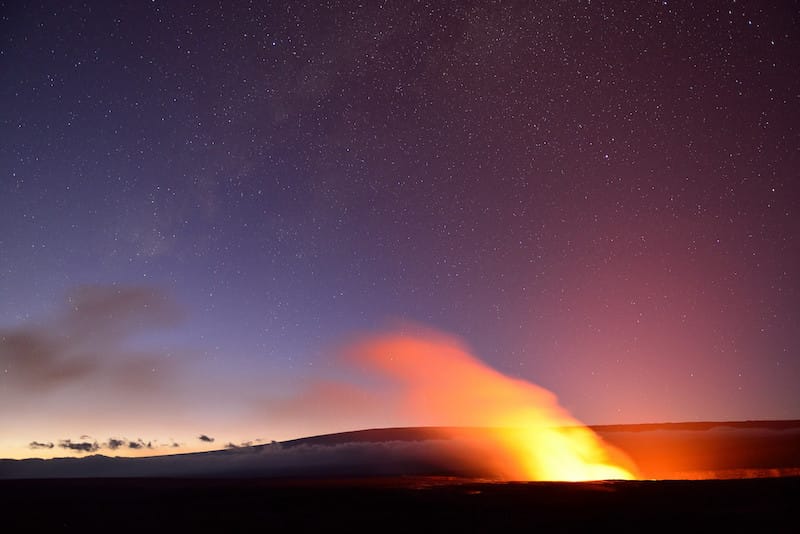
Alternatively, you can visit some places near Hawaii Volcanoes National Park (and inside!) that we think are worthwhile! Here are a few of our top favorites to add to your Hawaii Volcanoes National Park itinerary.
Mauna Loa Lookout
The Mauna Loa Lookout, located at the end of an 11-mile journey outside of the park, offers a stunning viewpoint. The region offers panoramas of the Kilauea Crater and serves as the starting point for hikes to the world’s largest subaerial volcano.
The Mauna Loa Strip Road leads travelers to the overlook, which is located at an elevation of 6,662 feet (2031 meters). It’s a one-way road with a length of 11.2 miles in total.
The trek to the summit is a major challenge, so amateurs are discouraged from doing the hike and it is best if you have more than 24 hours in Hawaii Volcanoes National Park dedicated to this trail nearby.
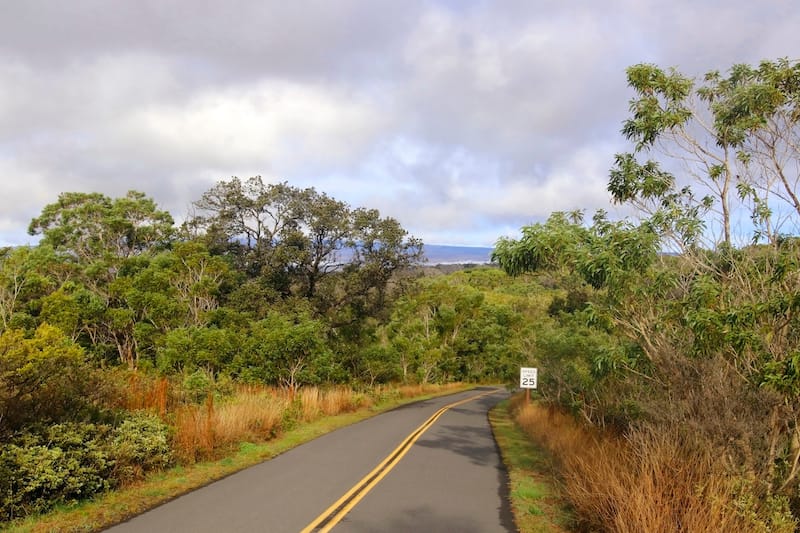
The trail traverses through steep, jagged, and frequently unstable lava on its way to the peak, which is at a high elevation. It’s mostly because of this that the area is difficult to climb.
Furthermore, the trail is marked by stacked rocks and could be difficult to locate in limited visibility situations.
It’s only possible to stay here for three nights in a row. If you’re considering a trip here, keep in mind that you’ll need to be well-prepared and have some experience with high-altitude trekking.
You’ll be surrounded by the sounds of wonderful tropical birds during your visit, and if you’re lucky, you might even see the rare ‘i’iwi bird.
Maunaulu / Pu‘uhuluhulu Hike
If you have two days in Hawaii Volcanoes National Park, definitely consider the Maunaulu / Pu‘uhuluhulu Hike.
This lunar-like landscape is from the 1969-1974 Maunaulu lava flow and eruption and you will find a variety of landscapes there (it is a geologist’s dream)!
It is a moderate trail that includes mostly easy terrain but there is a small 1/4 mile climb up the Pu‘uhuluhulu cone that can be slightly challenging.
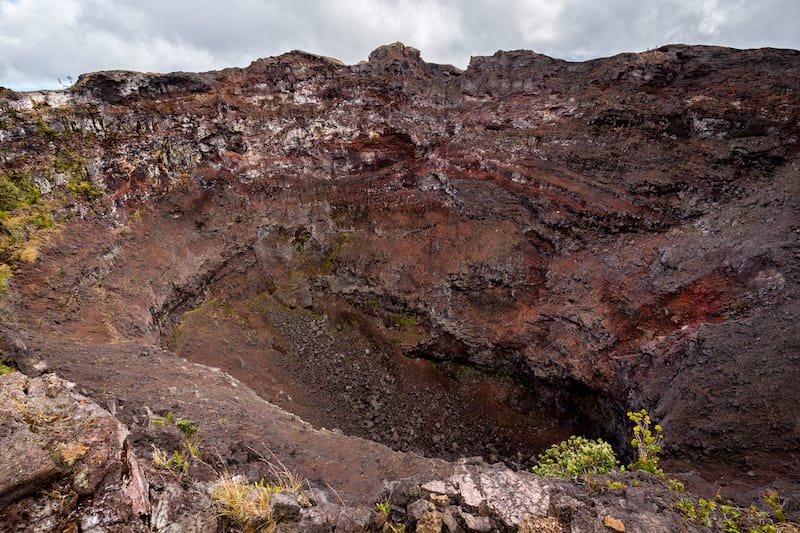
The trail is 2.5 miles long and takes around 2-3 hours. Please note that the beginning of the trail is an easy, beginner-level trail that will be crowded.
The trailhead is 100 yards from the parking area at Maunaulu. You will see stacked rocks that mark the trail along the way – do not move them and please stay on the trail!
Punalu’u Black Sand Beach
The Big Island black sand beach is a popular stop on the way to Volcanoes National Park.
Situated between Pahala and Naalehu on the southeastern Kaʻu coast, Punaluu Black Sand Beach is one of the distinguished areas on the Big Island.
The black sand formed as a result of the rapid cooling of basaltic lava that hit the ocean water and shattered into tiny pieces.
The waves pushed the sand black to shore, so the beach evolved. Punaluu is home to endangered Green Sea Turtles and Hawksbill Sea Turtles.
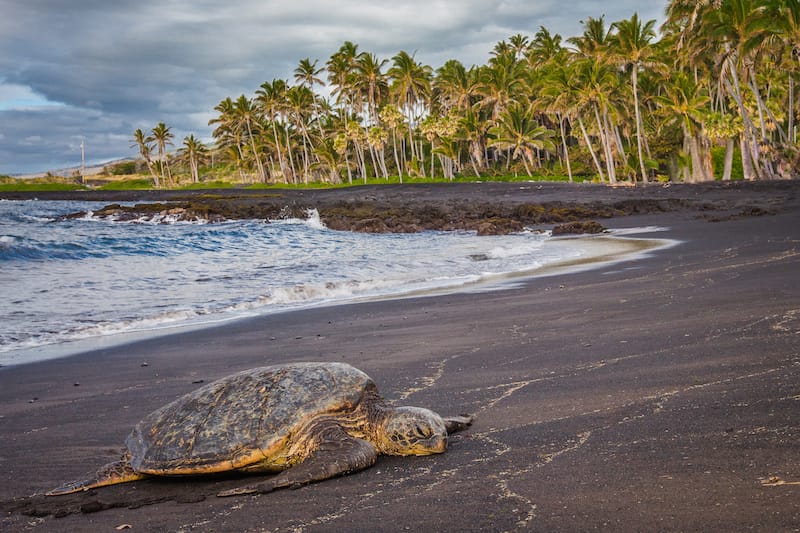
One can see them chilling along the sand, staying warm in the sun. Please do not touch them and never block their access to the sea or land.
If the weather is calm, you can swim or snorkel in the bay. Behind the beach, you’ll find a freshwater pond with alluring views of water lily plants.
Have you ever taken a day trip to Volcanoes National Park? Let us know your top tips for a one day in Hawaii Volcanoes National Park itinerary below.
Other Hawaii Itineraries
More Big Island Travel Guides
- Things to do on the Big Island
- Big Island itinerary
- Day hikes in Volcanoes National Park
- Best beaches on the Big Island
- State parks on the Big Island
- Best things to do in Hilo
- Top things to do in Kona
- What to do in Waikoloa
- Waterfall hikes on the Big Island
Pin this Day Trip to Hawaii Volcanoes National Park Guide
